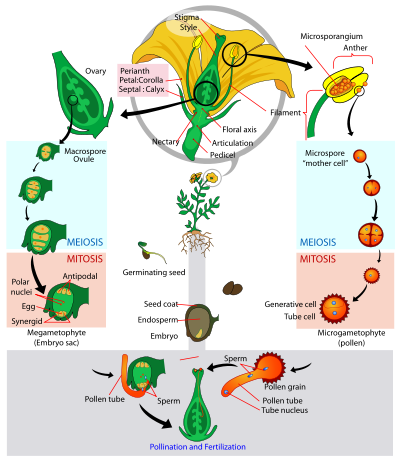"Let's get it on..." Well, not exactly.
The flowering plant, or Angiosperm, of Castanea dentata reproduces sexually through its male and female reproductive structures located within the flowers. The diagram below illustrates the process of pollination and fertilization as well as the germination of a general angiosperm.
Angiosperms undergo an alternation of generations throughout its lifetime of nutritionally independent sporophytes and gametophytes which are nutritionally dependent on sporophytes.
The chestnut tree is monoecious, meaning that both the male and female flowers exist on the same tree. Therefore, it is capable to pollinate oneself however, it usually requires cross-pollination due to protogynous blooming. The word protogynous refers to a flower in which the stigma is receptive to pollination before the pollen is actually shed from the anther of the same flower or tree. C. dentata is pollinated through wind which transports the pollen grains to eventually contact the embryo sac within the ovary of the flower. After fertilization, the ovule eventually develops into the seed, or chestnut, and the ovary develops into the fruit, or prickly bur surrounding the nut. Below is a good representation of the long male catkins, which are now dead, and the developing fruit of the female ovary that contains the seeds. Eventually, the fruit will ripen, fall from the trees and crack open on the ground, exposing the chestnut within.
As a side note, the chestnut tree is also capable of asexual reproduction via sprouting shoots, such as those that have died from blight with remaining roots. However, generally the tree requires cross-fertilization, as described above, for successful reproduction. Plus, most shoots of asexual reproduction do not survive long enough to flower and produce viable seeds.
Unlike most other nut trees, those that receive adequate pollination produce a dependable nut crop almost every year. That is if the tree is healthy and free of blight, however. Other such nut trees that provide nut crops, but possibly not as predictable, are the almond, cashew and pistachio trees which may have to overcome barriers of pollination or just bloom at unreliably.
The best seasons for chestnuts are autumn and early summer. In the fall, as noticed in any northern Wisconsin forest, trees change from green to dark burgundy, burnt orange and golden yellow. The chestnut tree will turn to a gold fall foliage and the nuts will harvest at this time. In early summer, one can experience the blooming period of the chestnut tree, as massive white flower bearers depicted below.
Continue on to learn about how Castanea dentata interacts with its archenemy and the benefits it provides.
Feel free to check out other students' pages as well as our University's website below:
